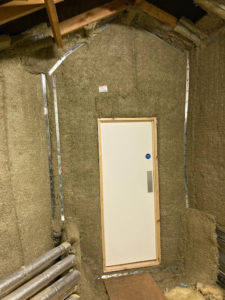Contractor Novus Property Solutions is investing further in the compliance works it carries out on behalf of local authorities. One of the key services it offers is the installation of loft compartmentation. Here, Compliance Works Manager, David Barnes, explains why this measure should be regarded as an essential fire safety feature across the public sector.
While it’s always been an important subject when it comes to local authority buildings, compliance has understandably taken centre-stage within the build and refurbishment sector since 2017. Of course, cladding — and which materials are suitable for use — has remained at the forefront of discussions. However with cladding the key focus for compliance in local authority buildings, especially for high-rise social housing, it can be easy to overlook other fire safety measures which are ultimately equally as important.
Compliance is key
Lessons in compliance continue to be learnt across the sector as it works to ensure that the events of 2017 are never repeated. It goes without saying that fire endangers the life of both residents and those involved in rescue and clean-up operations, as well as leaving behind high levels of destruction, which can be both costly and time-consuming to repair. For these reasons, fire safety measures have become a key focus for both local authorities and social housing landlords in recent years, which have resulted in significant investment in compliance measures for new-builds and in remedial works for existing buildings.
Fire moves quickly in concealed spaces, and particularly in high-rise buildings, loft spaces can present a severe risk of rapid spread — so it’s essential that precautions are taken in such areas.
Loft compartmentation provides a solution to this potentially life-threatening problem as it is ultimately designed by specialist manufacturers to prevent the spread of flames through the use of barriers, which subdivides the loft space into areas of manageable risk. Non-load bearing vertical or horizontal barriers are constructed to provide and extend fire separation into the loft space from the identified compartment walls and floors below; slowing the movement of the fire.
 A versatile solution
A versatile solution
Novus has seen an increase in requests for loft compartmentation for local authority buildings — with its East Midlands region alone having carried out more than 50 installations. While many requests have been for sheltered housing schemes, Novus’ work in this field has also taken place across a variety of local authority buildings, including hospitals and universities. The solution is specially designed by manufacturers to fit the requirements and space available, with the design of the loft compartmentation based on a building’s marked floor plans.
Contractors like Novus will work directly with clients to ensure the layout of the loft compartmentation is the perfect fit for each building. This includes identifying where the barriers are required and how much extra time they should give — 30 minutes, 60 minutes and 120 minutes are the most commonly requested integrity ratings.
Building Regulations also often require fire barriers to have the same integrity and insulation values as the wall or floor on which they will be mounted, so this will be accounted for with the fire barrier product selection. Compartment wall identification is dependent on the building’s fire risk levels and can be installed to suit existing arrangements depending on the roof construction.
Looking to the future
Loft compartmentation should be seen as an essential investment for local authorities in the provision of fire safety measures. It will ultimately save the lives of residents in social housing — and users of other local authority buildings where it has been installed — by reducing the spread of flames and buying more time for evacuation.
It’s particularly important for buildings where the top levels are frequently used, such as flats where there is high occupancy on the top floors. Loft compartmentation in such buildings is often incorporated into the evacuation plan requirements, so it’s also worth considering its installation in communal areas, which are used as escape routes.
By investing in loft compartmentation now as part of fire safety measures, local authorities will reduce the risk of the physical, financial and emotional toll of fires in the future.









